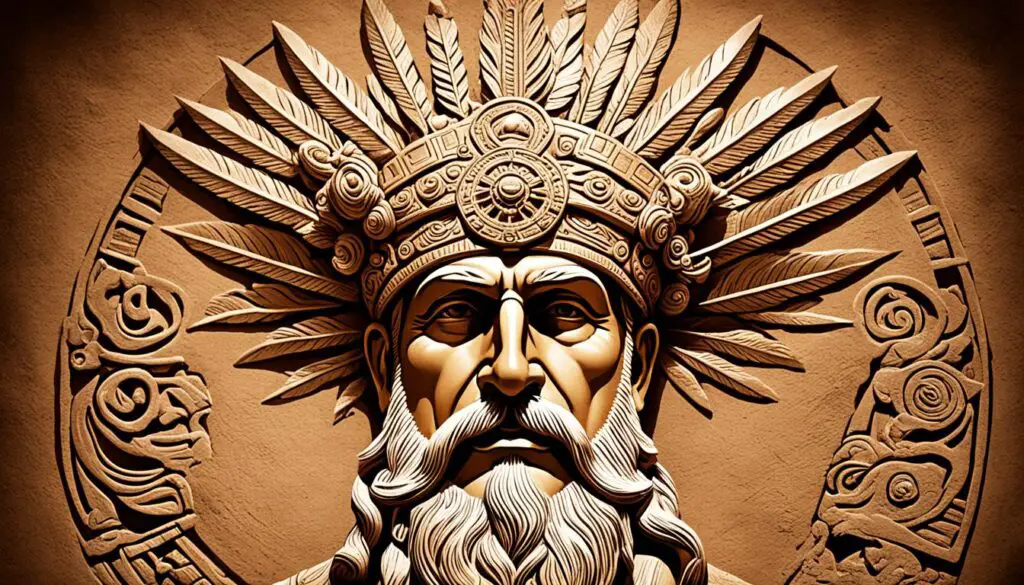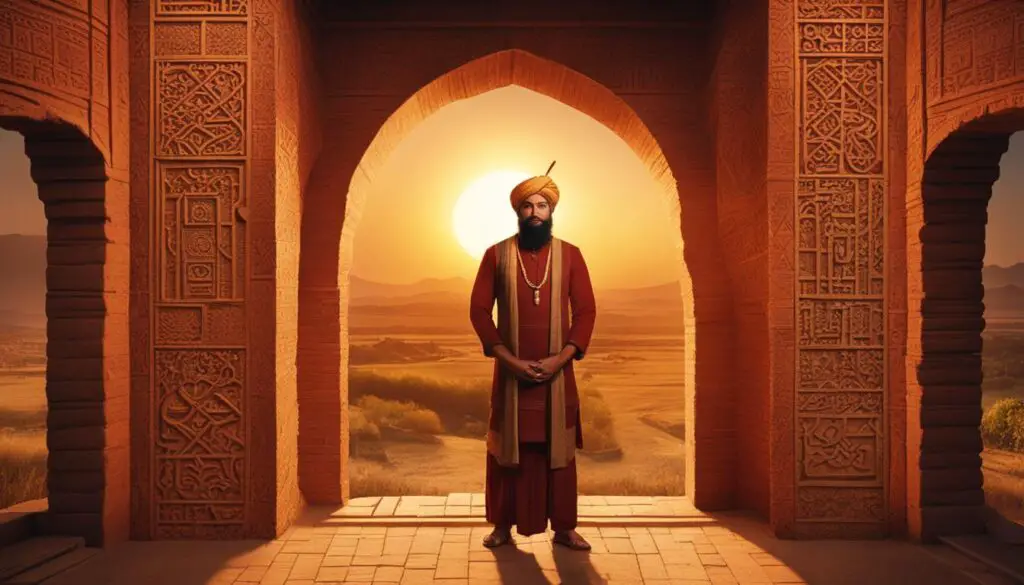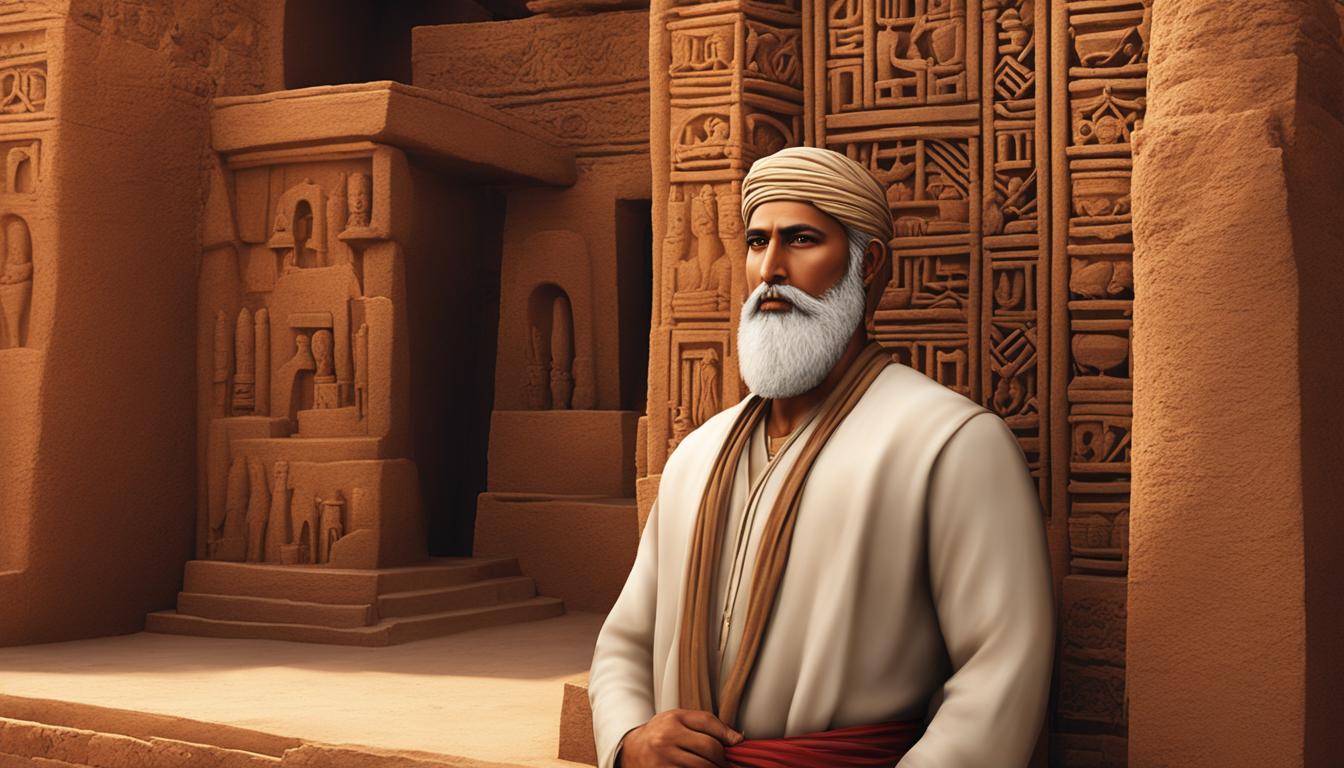The bearded man of Harappan civilization is a remarkable archaeological discovery that sheds light on the ancient Indus Valley civilization. This small male figure, sculpted in steatite, was unearthed in Mohenjo-daro, Pakistan, dating back to around 2000-1900 BCE. Known as the Priest-King or King-Priest, this sculpture is considered the most iconic stone carving of the Indus Valley civilization. Portraying a bearded man adorned with an armband and a cloak adorned with intricate motifs, it now resides in the National Museum of Pakistan.
Key Takeaways:
- The bearded man of Harappan civilization is a significant archaeological discovery from the Indus Valley civilization.
- The sculpture, made of steatite, depicts a bearded man in luxurious attire, suggesting a figure of authority.
- This sculpture is a symbol of the rich cultural and historical heritage of the ancient Harappan people.
- Harappan art and architecture exhibit advanced skills and artistic sensibilities, as seen in the bearded man and other stone statues.
- The bearded man’s legacy encompasses the fascination and curiosity of historians and art enthusiasts, representing a valuable piece of our shared human history.
The Symbolism of the Bearded Man
The bearded man of Harappan civilization holds great symbolic significance. The sculpture’s portrayal of a bearded man with a fillet around his head suggests a figure of authority, possibly a priest or a king. The meticulous craftsmanship and attention to detail in the sculpture’s features and attire indicate the high social status of the individual depicted. The bearded man is often associated with the religious or ancestral figures of the ancient civilization. Its image has become an enduring symbol of the civilization and a representation of the rich cultural and historical heritage of the Harappan people.

Art and Architecture of Harappan Civilization
The art and architecture of the Harappan civilization showcase the remarkable skills and artistic sensibilities of its people. Through the discovery of sculptures, seals, pottery, and terracotta figures at various sites, we gain valuable insights into their creative expression.
The stone statues found at Harappa and Mohenjo-daro are exceptional examples of three-dimensional artistry. These statues, including the famous bearded man and male torso, demonstrate the mastery of carving and sculpting techniques during that time.
The terracotta figures provide a glimpse into various aspects of Harappan life. Among them, the representation of the mother goddess and bearded males with coiled hair stand out. These figurines display the intricate details and craftsmanship that characterized the art of the Harappan civilization.
Moreover, the seals found at Harappan sites, crafted from steatite and other materials, feature elaborate engravings of animals such as unicorns, tigers, elephants, and bulls. These seals not only served as identification marks but also showcase the artistic flair of the Harappan people.

Achievements in Harappan Architecture
The Harappan civilization also left behind impressive architectural marvels. The cities of Harappa and Mohenjo-daro, with their well-planned layouts and advanced drainage systems, indicate a high level of urban planning and engineering.
The buildings, constructed with baked brick, were multi-storied and adorned with intricate designs. The Great Bath, a prominent structure in Mohenjo-daro, is a testament to the advanced architectural techniques employed during that time. It features a sophisticated water management system, showcasing the engineering prowess of the Harappan people.
Comparison of Harappan Art and Architecture
| Art | Architecture |
|---|---|
| Stone sculptures with exceptional three-dimensional handling of volumes | Well-planned cities with advanced drainage systems |
| Terracotta figures portraying various aspects of life | Multi-storied buildings constructed with baked brick |
| Seals featuring intricate engravings of animals | Structures adorned with intricate designs |
The art and architecture of the Harappan civilization are a testament to the creativity, skill, and advanced knowledge of its people. These cultural artifacts provide a fascinating glimpse into the rich heritage of the Indus Valley and the enduring legacy of the Harappan civilization.
The Legacy of the Bearded Man
The bearded man of Harappan civilization continues to captivate and intrigue historians, archaeologists, and art enthusiasts alike. This iconic sculpture serves as a testament to the creativity, artistic skill, and cultural significance of the ancient Indus Valley civilization.
The bearded man’s image has been reproduced and replicated in various forms, becoming a widely recognized symbol of the Harappan culture. Its legacy extends beyond the boundaries of the Indus Valley, representing a valuable piece of our shared human history.
By studying and preserving the bearded man and other artifacts of the Harappan civilization, we gain a deeper understanding of our ancient past and the fascinating civilizations that came before us. The bearded man serves as a bridge to an ancient world, allowing us to connect with the rich heritage and cultural traditions of the Indus Valley civilization.
FAQ
What is the significance of the bearded man of Harappan civilization?
The bearded man of Harappan civilization is a significant archaeological discovery that provides insight into the ancient Indus Valley civilization. It is a small male figure, sculpted in steatite, found in Mohenjo-daro, Pakistan, dating back to around 2000-1900 BCE. Known as the Priest-King or King-Priest, this sculpture is considered the most famous stone sculpture of the Indus Valley civilization.
Who is the bearded man of Harappan civilization believed to represent?
The bearded man of Harappan civilization is believed to depict a figure of authority, possibly a priest or a king. The fillet around his head suggests his association with religious or ancestral figures of the ancient Indus Valley civilization.
What does the bearded man’s image symbolize?
The bearded man’s image symbolizes the rich cultural and historical heritage of the Harappan people. Its portrayal of a bearded man with intricate attire and meticulous craftsmanship signifies high social status and artistic excellence.
What artistic expressions can be found in the Harappan civilization?
The Harappan civilization exhibits advanced artistic skills in various forms. Stone statues found at Harappa and Mohenjo-daro, including the bearded man and a male torso, showcase exceptional three-dimensional handling of volumes. Terracotta figures depict aspects of life, such as the representation of the mother goddess and bearded males with coiled hair. Intricate engravings of animals can be seen on seals made of steatite and other materials.
Why is the bearded man of Harappan civilization significant today?
The bearded man of Harappan civilization continues to capture the fascination of historians, archaeologists, and art enthusiasts. It represents the creativity, artistic skill, and cultural significance of the ancient Indus Valley civilization. The image of the bearded man has become an enduring symbol of the Harappan culture, extending beyond the boundaries of the Indus Valley and serving as a valuable piece of our shared human history.
